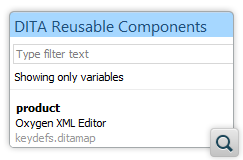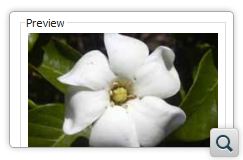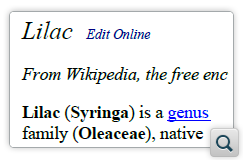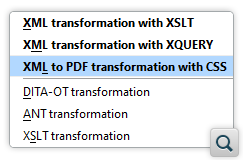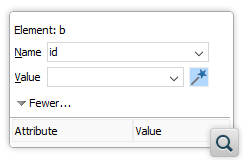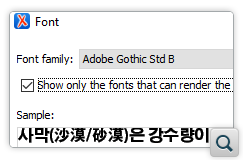What's New in Oxygen XML Author 21.0
The release of version 21 of Oxygen XML Author adds
numerous new features, updates, and improvements to the already robust, industry-leading XML
authoring application. The primary focus for this major release was to evaluate user
requests for improvements and additions, implement as many of them as possible, while
preserving the reliability, stability, and performance requirements that the XML community
has come to expect from the Oxygen suite of products.
This major release includes numerous productivity improvements for DITA
authors, the CSS-based PDF Publishing support and the Oxygen PDF
Chemistry engine were enhanced with many new possibilities for improving PDF
output, as well as updates to add-ons, new API entry points, component updates, performance
improvements, and much more.
Collaboration for your XML documentation review process is now readily available since
the Oxygen Content Fusion connector add-on is already installed in Oxygen
XML Author.
There are changes in:
DITA Authoring
Improvements to DITA Reusable Components View
The
DITA Reusable Components view received more improvements. The
default display mode for the
Keys tab now has a
tiles
style of layout and additional filtering and sorting options were added to help you search
for keys. Also, a new action was added in the Settings menu of the
Components tab to force a re-indexing of the reusables.
Quick Fix to Correct Capitalization in Paths
A quick fix was added that can be used to correct capitalization problems in
file paths. For example, instances where you have an image or an
xref with an href attribute pointing to a resource and
the path to the resource is correct, but not properly capitalized
(C:\temp\myfolder instead of
C:\temp\myFolder).
Validate and Check for Completeness Gathers Keys from Root Map
The
Validate and Check for Completeness operation now gathers
keys from the map specified in the
Root Map combo box. This means that
you can now validate submaps (for example, to check for broken links), but the keys will
be gathered from the root map.
Preview Image Before Inserting It
When inserting images in DITA topics, the Insert Image dialog
box now includes a preview box so that you can see the selected image before clicking
Insert.
Key Reference to Image Presents Preview Thumbnail
If you have a key defined for an image in a DITA map, when you reference it in
a DITA topic, you now have the ability to see a preview thumbnail of the image in the
in-place attributes editor or the Attributes view.
Support for Profiling Conditional Attribute Groups
You now have the ability to
define profiling
attribute groups to organize the attribute values into hierarchical conditions.
This is intended to support situations where an attribute applies to multiple specialized
subcategories. The same support for single profiling attributes is available for groups.
For example, you can configure the colors and styles for group values, defined groups are
listed in the content completion window, and the groups are presented in all the same
locations in the application.
DITA Maps Automatically Indexed
When opening a DITA map in the DITA Maps Manager, its index will automatically
be refreshed by default. There is a new option in the Open/Find Resource
preferences page where you can disable this feature.
DITA Maps Metrics Report Improved
The DITA Map Metrics Report transformation scenario was
improved to also list all @outputclass attribute values gathered from the
DITA project.
Better Support for Editing DITA-OT Plugin Configuration Files
When editing a DITA-OT plugin.xml configuration file, placing
the cursor inside the value of an extension attribute and invoking the
content completion will present a list of possible extension points with links to the
DITA-OT documentation.
Open Next Document that Contains Review Items
When navigating items in the Review view, if you reach the last/first review
item in the document, clicking the navigation button again will open a dialog box asking
if you want to open the next/previous document (from the current DITA map hierarchy) that
contains review items. You can also configure this behavior with a new option in the DITA
preferences page.
DITA CSS-based PDF Publishing
Add an Edit Link in the PDF Output for CSS-Based PDF Transformations
It is now possible to
add an "Edit"
link next to the topic title in the PDF output. When a user clicks the link, the
topic is opened in
Oxygen XML Web Author where they can offer suggestions
or make changes that can be saved to a file server.
Control How Tracked Changes and Comments are Presented
It is possible to
control how the
tracked changes and comments are presented. They can be shown as PDF annotations
or as footnotes. PDF Annotations are specially handled by PDF viewers, such as Adobe
Acrobat Reader. The annotations contain information about the author, comment, part of the
affected content, the date, and replies.
Navigation Title Used for Bookmark Labels
You can use the navtitle element in a topic or a topic
reference in a map to adjust the labels for the PDF bookmarks. PDF Bookmarks are used to
generate a hierarchical structure similar to a table of contents in a specialized view of
your PDF Reader.
Generate List of Tables and Figures from a Bookmap
Support was added for generating a list of tables or figures when using a DITA
bookmap. They can be defined inside a 'booklist' element in the frontmatter or backmatter
of a bookmap. For more information about this and other ways to control content using a
bookmap, see
Controlling
the Publication Content.
Alter Styles Through Custom Parameters
You can activate parts of your CSS by using custom transformation parameters.
These parameters are recognized by the publishing pipeline and are forwarded as synthetic
attributes on the root element of the merged map. For more information, see
Styling Through Custom
Parameters.
Fixed Various DITA-OT Transformation Parameters
The args.gen.task.lbl, args.figurelink.style,
and args.tablelink.style DITA-OT parameters now work properly when
generating PDF output based on CSS and HTML5.
Hazard Statement Icons Updated
When the DITA hazardstatement element is used, the icon that
appears in Author mode and the output was updated according to the ISO-3864
standard.
Parameter to Control Numbering
A new parameter (
args.css.param.numbering) can be used to
control the way numbering is implemented. When set to
shallow, only the
first-level topics (the chapters) are numbered. When set to
deep, all the
chapters and subsections are numbered. For more information, see
How to Switch Between
Shallow and Deep Numbering.
DITA to Responsive WebHelp
Topic Path Breadcrumb is Displayed in Search Results Page
In the Search Results page, you can now see a breadcrumb of the path of all of
the topics that contain the search results. It makes it easier to visualize where the
topic exists in the hierarchy and you can click any of the topics in the breadcrumb to
open that particular page.
WebHelp Compatible with DITA-OT 3.x
Oxygen WebHelp has been tested and is compatible with the latest DITA Open
Toolkit version 3.x.
XML Refactoring Operation to Migrate HTML Page Layout Files to Version 21
For custom publishing templates that were created in version 20.1 and that
include custom HTML page layout files, a conversion procedure is required for the template
to be compatible with version 21. A new XML Refactoring operation was added to make this
conversion very easy. For details, see
Converting Old Templates with
HTML Page Layout Files to Version 21.
Other
Automatically Recover Documents
An option is now available to
automatically save the
currently modified documents to backup files. This makes it possible to recover
content after system crashes or other problems. By default, the option is enabled and it
saves the content of each modified file to the backup file every 5 minutes, but this can
be configured in the
Save preferences page. In the event of a crash, when you
restart the application or open a document that was being edited before the crash, a
dialog box is displayed with options for how to handle the auto-recovered
information.
New Built-in Transformation Scenario Type for CSS-Based PDF Output
You now have the option to create transformation scenarios based on a new
scenario type called
XML to PDF Transformation with CSS. It uses the
Oxygen PDF Chemistry processing engine to obtain PDF output by applying
CSS styling to an XML document.
Open Resource in Console (Terminal)
A new contextual menu action was added in the Project view
that can be used to open a command console at the location of the selected physical
resource. If the selected resource is a file, the console will open at the parent
directory.
Filter Review View to Show Items in Current Document Only
A new filter was added in the Review view called Show
reviews in read-only content. You can deselect this filter to only show review
items in the current document and exclude review items from content referenced in a
conref or conkeyref.
Automatically Generate IDs in Attributes View
When using the Attributes view or the in-place attributes
editor for any of the built-in frameworks, if the selected attribute is named
id, a Generate Unique ID Value button is available.
Clicking this button will automatically generate a unique ID value for the selected
element.
Learn Words Directly from Results Panel
When misspelled words are reported in the Results panel after
using the Check Spelling in Files action, you now have the ability to
choose to Learn words using a contextual menu action directly in the
Results panel.
Replace Content Without Finding the Next Instance
When using the Find/Replace dialog box, the
Replace button now only replaces the current match without advancing to
the next instance. There is now an additional button (Replace/Find) that
can be used for that purpose.
Show Unreferenced Resources in System Explorer
When using the Find Unreferenced Resources action on a DITA
map, any resources found and listed in the Results panel can be previewed
by selecting Show in Explorer from the contextual menu.
Bookmark Shortcuts Automatically Open Closed Documents
Bookmark navigation shortcuts (CTRL+1 through
CTRL+9) now work even if the document where the bookmark was inserted
has been closed. In this case, using the shortcut will automatically re-open the
document.
Automatically Detect Fonts for Certain Character Sets in the Fonts Preferences
Page
When choosing a font for various UI components in the
Fonts
preferences page, the font chooser dialog box now includes an option to
Show only the fonts that can render the sample text. If you select this
option and paste content in the
Sample area, Oxygen will detect fonts
that can render the particular character set and filter the fonts that can be selected
accordingly. This is helpful is you're trying to determine the font to use for a character
set with special characters (for example, Asian languages).
Huge File Editor Improved
The
huge file
editor now supports editing files that have Windows-1252/CP-1252 or ISO 8859-1
encoding.
MathML and SVG Graphics Improved for Retina/HiDPI
The quality of the rendering of MathML and SVG images was improved for
Retina/HiDPI displays.
Exist 4.5 Officially Supported
Exist 4.5 was tested and is now officially supported.
XLiff 2.1 Supported
Added support to create, edit, and validate XLiff 2.1 documents.
Documentum xDB (XHive) Support Removed
Support for the Documentum xDB (XHive) database was entirely
removed.
API
Customize Default Rendered Topicref Title
Create an Anchor at a Certain Offset
Serialize Persistent Object to an XML String
De-serialize Persistent Object
Move Keyboard Focus to Current Editing Mode
Get Key Definition for a Target URL
Add-on Updates
Batch Converter Add-on Now Includes Excel to DITA
Oxygen Content Fusion Connector Add-on Pre-installed
The Oxygen Content Fusion Connector add-on now comes
pre-installed with Oxygen.
Git Client Add-on Includes JGit 5.2.1
Saxon Transformer Add-on Updates
Updated the 9.9 version of the
Saxon transformer
add-on to support Saxon version 9.9.1.1. The 9.8 version of the add-on was also
updated to use Saxon 9.8.0.15.
Component Updates
Apache Batik 1.10.x
Updated the Apache Batik SVG toolkit to version 1.10.x.
Apache FOP 2.3
Updated Apache FOP to version 2.3.
Calabash 1.1.24
Updated the Calabash engine to version 1.1.24.
Chemistry PDF Processor 21.0
DITA Open Toolkit 3.2.1
Updated the bundled DITA Open Toolkit publishing engine to version
3.2.1.
EPUBCheck 4.1.1
The EPUBCheck tool that is used to validate EPUB files was updated to version
4.1.1.
Eclipse 4.9 and 4.10
The Oxygen Eclipse plugin was updated to officially support the latest
Eclipse versions 4.9 (2018-09) and 4.10 (2018-12).
SVNKit 1.8.15
Updated the bundled SVN client to use SVNKit 1.8.15.
TEI Schemas 3.5 and TEI Stylesheets 7.47
Updated the bundled TEI schemas to version 3.5 and the TEI stylesheets to
version 7.47.
XSpec 1.2
Updated the XSpec version to 1.2.

